|
Berry Springs is an interesting place because it contains both park areas and natural areas. One of the benefits of natural areas is that they contain a plethora of plants and animals and Berry Springs is no exception. Like many parts of Texas one will run across the occasional snake and it is good to be able to understand how to react and to recognize them!
Snakes are strictly carnivorous and are a vital part of any balanced ecosystem. They play an important role in controlling rodents and insects. The majority of snakes are non-venomous and only attack humans in self-defense. The best way to deal with a snake if you see it is to leave it alone. Most snakes will leave you alone if you do the same. One exception is the Cottonmouth, also known as the water moccasin. It is territorial and will approach you if you infringe on its territory. Withdrawal is the best solution when this happens to you. Listed here are some of the snakes that have been seen at Berry Springs.
Every snake bite is dangerous as the wound can always become infected. For this reason they should all be taken seriously.
If you are bitten do not try to treat the wound yourself. Instead call the Texas Poison Center Network free hotline at 1-800-222-1222 or if you are having trouble breathing or are dizzy dial 911.
|
Poisonous Snakes |
Copperhead
Agkistrodon contortrix laticinctus |
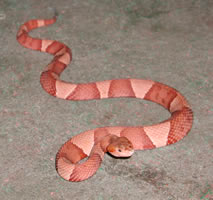
|
The copperhead is a member of the dreaded pit viper family. It can often be found near water or in forested areas. It is a hunter of insects and will wait quietly for its dinner to pass by. So beware! It spends a lot of time without moving. In addition, if a human passes by it might choose to run or freeze in place hoping to be ignored. Most copperhead bites occur because people accidentally step on the unmoving snake. So, if you see this snake you should definitely leave it in peace!
|
Texas Coral Snake
Micrurus tener |
|
Under no circumstances should you touch this quite colorful snake because it's hollow fangs contain a good quantity of a deadly neurotoxin! It is quite shy and feeds at night on snakes, burrowing small animals or the occasional lizard. This snake was sleeping about 50 feet from the small footbridge and due west of the monkey bars. As you can see it likes to sleep hidden in leaf litter or under logs during the daytime so do not play in the autumn leaf piles or turn over logs! If you are bitten by this snake you should see a doctor right away. The symptoms can take up to 12 hours to appear so do not be fooled. The good news is that there is a very effective antidote.
|
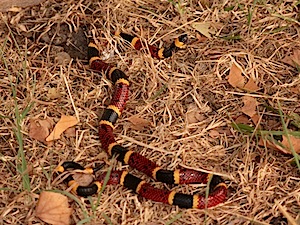
|
Cottonmouth - Water Moccasin
Agkistrodon piscivorus |
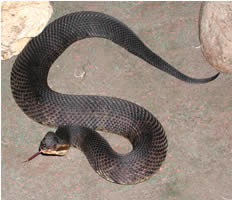
|
This semi-aquatic pit viper is fairly common in this area. It normally hunts small animals at night using 2 heat sensors found between its eyes and nose. It also has a good sense of smell. This territorial snake will normally avoid humans but can be quite aggressive if disturbed. It likes water but can also be found sunning itself in the open. It can grow to length of nearly 6 feet! The coloration is most often black or very dark but it can have grey, tan or yellowish-green patterns on its upper surface.
|
Western Diamondback Rattlesnake
Crotalus atrox |
|
This pit viper is the most likely rattlesnake that you will see in the park. They can be found in just about any habitat so beware! When you encounter one if it will normally try to avoid you and leave. If it feels threatened it may coil and rattle. It can strike nearly its full length so one should get away as quickly as possible. You can often tell the age of a young rattlesnake since one rattle is created each time it sheds its skin. After about a dozen or so rattles are created the end ones begin to fall off. It will eat rats, mice, rabbits, squirrels and many other small animals.
|
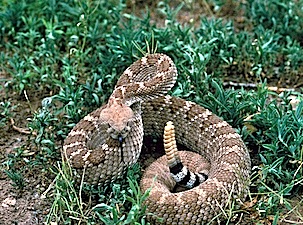
|
| |
| |
Non-Poisonous Snakes |
|
|

|
This is one of the larger snakes found at Berry Springs. It is often seen on the trails sunning itself or swimming across the pond. If you see a long crooked stick laying on the ground on one of the paths do not assume it is a stick because it could be a Rat Snake! It is normally a shy snake but will bite if disturbed or cornered. It has a huge appetite and will eat rodents, lizards, frogs and some types of insects and helps keep the wildlife in the park in balance.
|
|
|
|
This small snake is shy and very fast. It can be occasionally be seen next to or swimming in the creek behind the primitive camping areas or hunting near the dam. It can be recognized by the bright red strip down the top of its back. It loves to eat the tiny cricket frogs you hear making a huge racket near the creeks and ponds after sunset as well as the occasional lizard or small rodent.
|
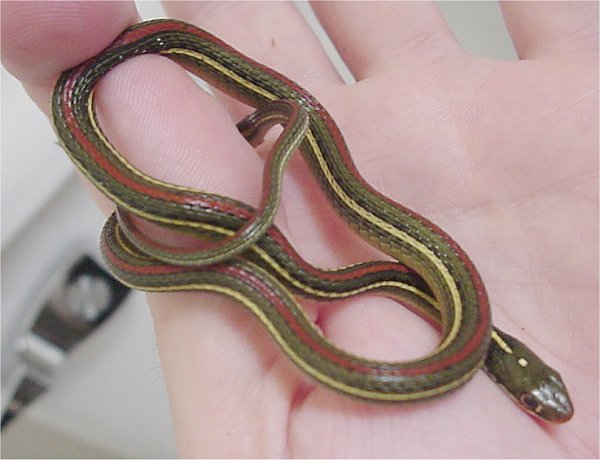
|
|
|
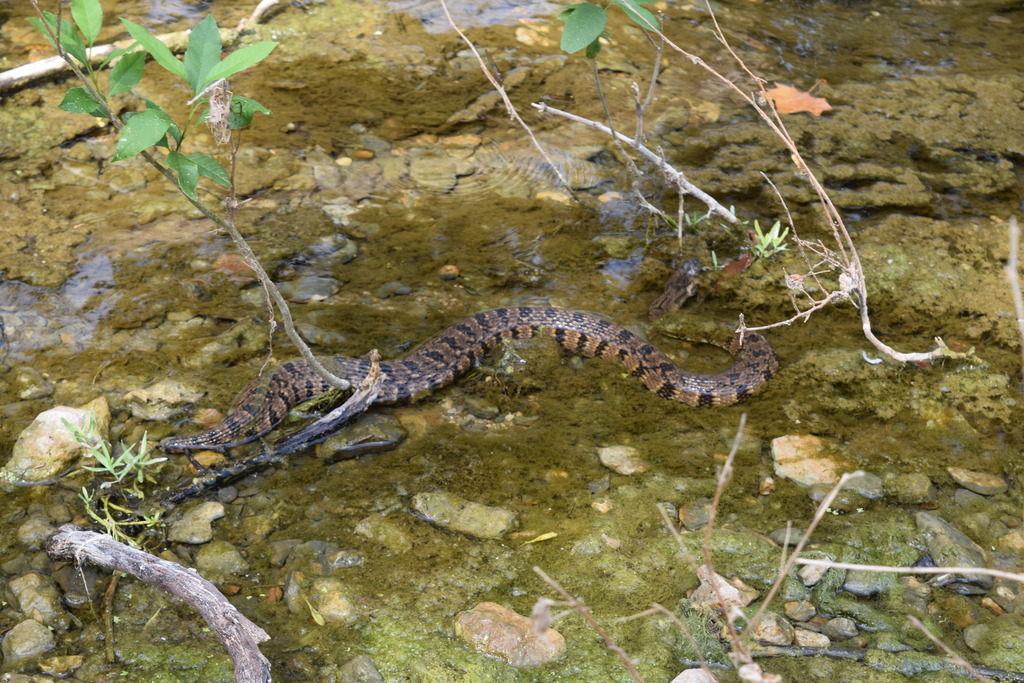
|
This reptile can be very large and is sometimes seen swimming just beyond the edge of the pier in the middle of the pond and sometimes in Berry Creek. It is probably living or hanging out under the pier. It also likes to hang in low lying branches above the pond waiting for something tasty to swim by. If approached it will drop into the water and swim away. It is often mistaken for a Water Moccasin or Rattlesnake and should not be harmed. It eats slow moving fish, frogs, crayfish and toads. It can hiss and bite if harassed and and so should not be handled for any reason.
|
|
|
|
This is one of the more interesting snakes at Berry Springs! It acts just like a skunk if you disturb it by emitting a foul smelling
musk odor and it will not hesitate to bite. Fortunately it is not venemous but it should be left alone as any bite can get infected. It
likes to eat crayfish, frogs, toads and tadpoles. It hangs out near streams and ponds and this one was seen sunning itself on the edge of the main pond. Another one was seen near the bridge next to the kids playground. When approached for a photo that one declined and swam away! Historically these snakes were considered to be a cross between the Yellow-bellied and Blotched Watersnake, but are now known as the Plain-bellied Watersnake based
on DNA mapping.
|
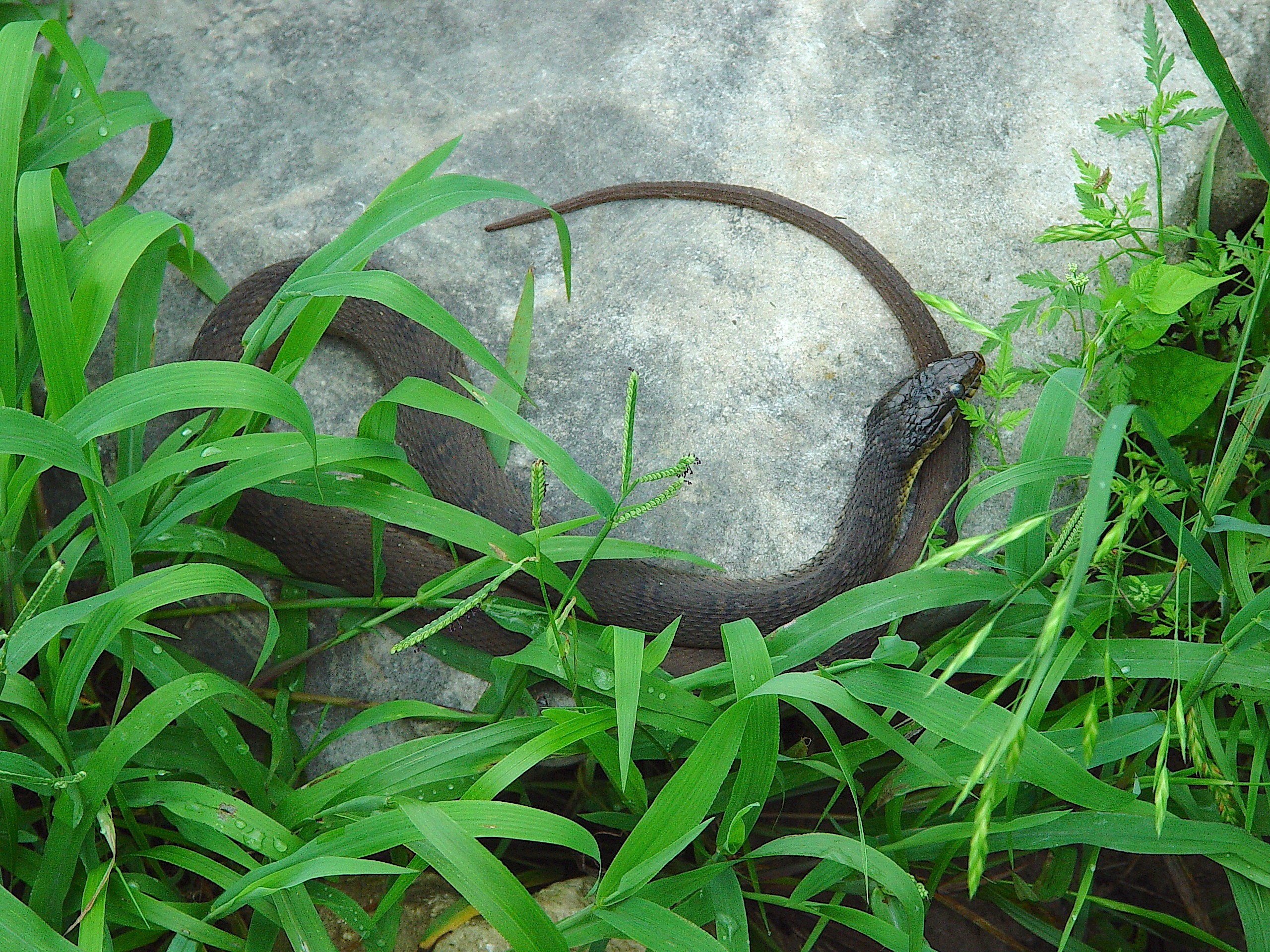
|
|
|
_1b.jpg)
|
This native snake has the most curious behaviour of any snake in the park. It is considered harmless but can bite of course. Shown here is the snake in its defensive flat-headed posture. If you frighten it then it will hiss at you. If that doesn't work then it will strike at you but it will (probably) not bite. Instead it will head butt you. Finally, it sometimes will even roll over and play dead! So do not pick it up if it seems dead!!! It is so widespread in the eastern half of the USA that it is known by more than 50 different names. Its color is incredibly variable and can contain patterns of red, green, orange, brown, gray or black in any combination.
|
|
|
|
This beautiful snake is slightly venomous but fortunately the venom is not a danger to people. It is found in many different habitats but prefers to live in forested areas as it often will climb trees looking for prey! It is not a picky eater and will kill and eat any animal small enough for it or eat bird's eggs. It kills by constriction and has even been known to kill Red-tailed hawks and large Owls. The young are light gray with brown blotches and slowly turns glossy black as an adult. It can be recognized by its white lips, cheeks and belly. It will grow up to 6 feet long and can weigh more than 4 lbs. Do not approach this snake as it can become very aggressive when cornered. If it is seen to be kinked then it is getting ready to attack and should be avoided.
|
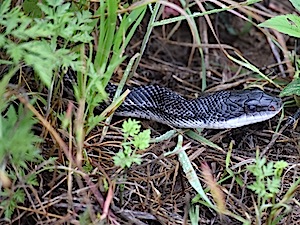
|
More Galleries
|








_1b.jpg)
